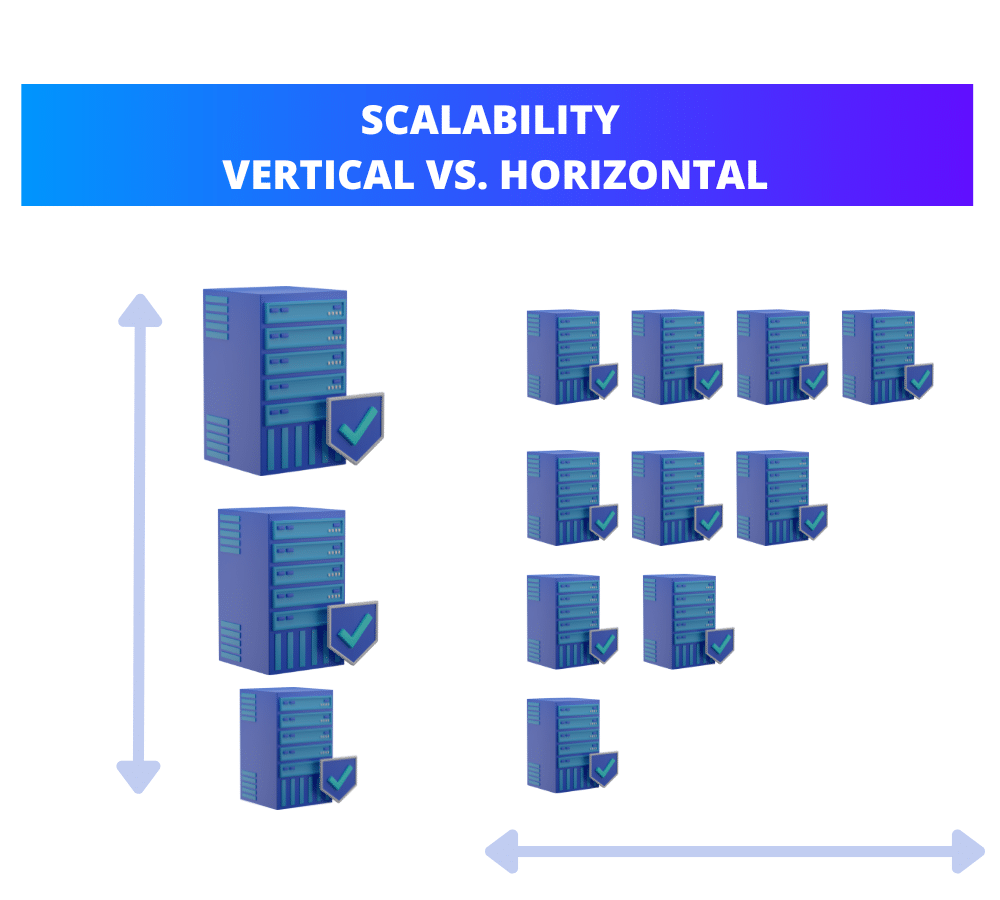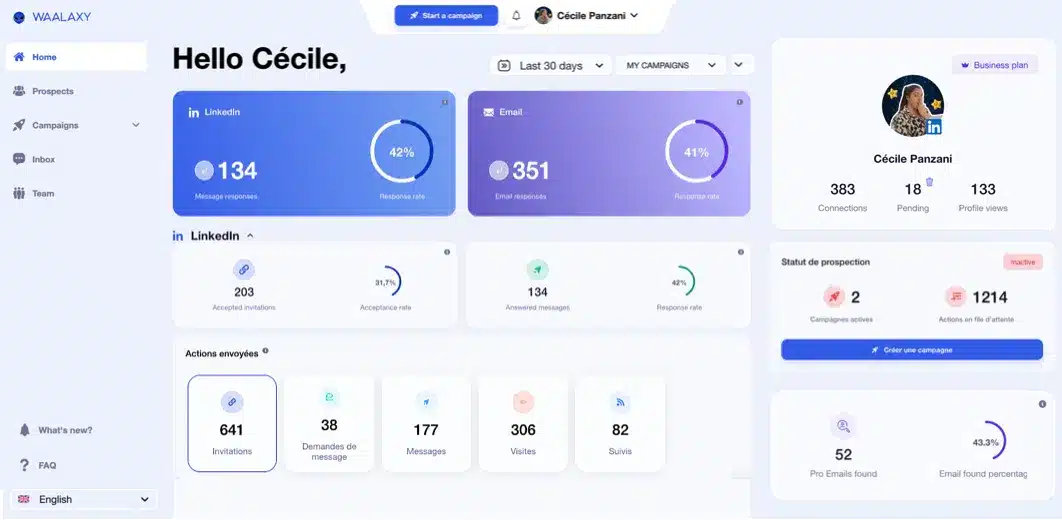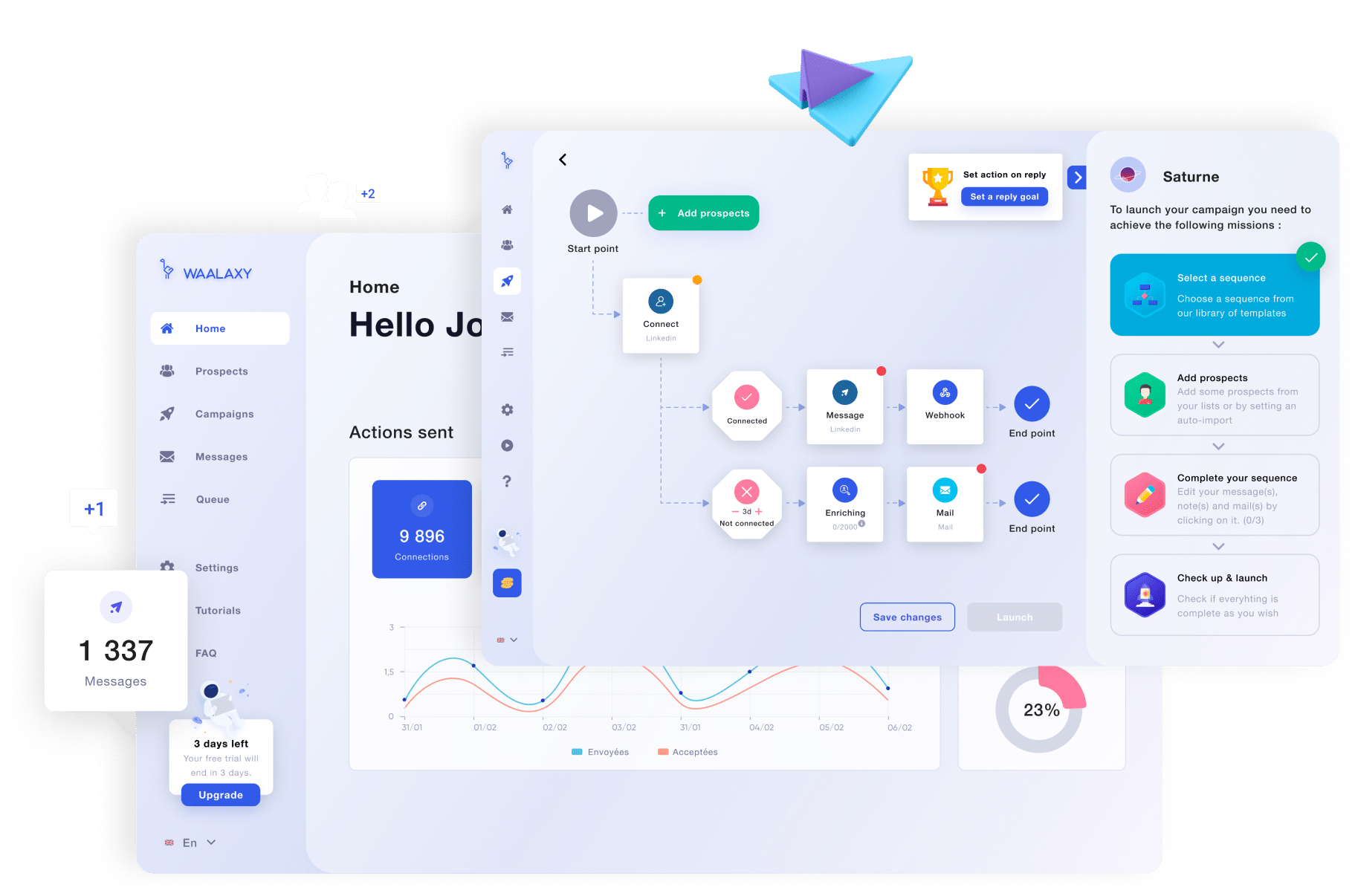In the start-up world, ambition runs high, dreams are big, and when it comes to growth—well, it has to be scalable! Think of it like building a rocket. You don’t just want it to launch—you want it to keep soaring, higher and higher, without crashing. That’s what scalability is all about for a startup. 🚀
But hold on, what exactly does scalability mean?
Scalability is the ability of a business or system to grow and handle an increase in demand without losing performance.
What is scalability?
The origin of the concept
Scalability is a term that originally comes from the IT industry. Picture a super-popular website: at first, everything’s running smoothly, but when thousands of users log in all at once, things can quickly turn into chaos. Being scalable means that the hardware can adapt to these changes, handling this surge in demand without sacrificing performance.⭐️
Scalability in start-ups
This concept has gradually made its way into the business world, where scalability refers to a company’s ability to grow quickly while keeping efficiency high and costs low. Take, for example, a start-up that sells online courses: whether 1, 10, or 10,000 people enroll, the additional effort required is minimal. That’s scalability in action! You can boost your revenue without your expenses skyrocketing. 🤯
The difference between a scalable and non-scalable business
The key difference between the two lies in the relationship between cost and profitability:
- A scalable business can grow its revenue and customer base without a corresponding rise in costs, allowing for fast and efficient growth. 😉
- On the other hand, an unscalable business experiences costs that rise in proportion to its revenue, which limits its potential for rapid and profitable growth. 💰
➡️ To help you understand, here are two examples:
- Scalable business: Imagine you develop a mobile app. As more users download it, demand rises. You can easily scale up storage to manage this demand, reducing loading times and enhancing the customer experience. This improvement draws in even more users, which in turn lowers the cost per download. With costs decreasing with each new wave of users, you’re able to offer competitive pricing, attracting even more people. And the cycle continues! ⭐️

- Non-scalable business: You operate a custom software development agency. As demand grows and more clients request projects, the number of developers you have remains limited. This leads to longer delivery times and a decline in service quality. As a result, projects take longer to complete, costs increase, and customers have to wait longer to receive their software. This situation pushes customers to seek alternatives elsewhere.

Types of scalability
There are two types of scalability: horizontal and vertical.👀
Horizontal scalability
Horizontal scalability, also known as “scaling-out”, involves adding more resources to cope with an increase in demand.This could mean expanding your space, bringing in additional machines, or hiring more employees to distribute the workload.💼
For example:
Consider a start-up offering a streaming service. As demand grows and the existing servers start to get overloaded, the company can simply add more servers to distribute the load, ensuring a seamless user experience. This approach allows the company to meet increasing demand without overhauling the entire system. 😎
✅ Its advantages:
- 💪🏻 More flexible: Resources can be easily added or removed as needed.
- 👾 Prevents bugs: With more hardware in place, the risk of downtime is reduced since other servers can take over if an issue arises.
- ⏳ Long-term sustainability : This is a sustainable solution because it doesn’t really have a limit.
Vertical scalability
Vertical scalability, also known as “scaling up,” involves boosting the capacity of existing resources. This can be achieved by adding more processing power, memory, or storage to a server or system. 💽
For example:
A startup offering an agile project management platform. If users increase and the current server starts to slow down, companies can upgrade it by adding more RAM memory or with more powerful processors. This increases space without the need to add new ones.👀
✅ Its advantages:
- 👶🏻 Simple: Easier to install, as it doesn’t require any changes to load balancing or overall system organization.
- 💸 Less costly: It’s a cheaper solution in the short term, as it doesn’t require major purchases such as new servers or additional hardware.
- 💤 Less management: With fewer hardware components to manage, operations are simpler, and maintenance costs are lower.

Which one to choose?
Here’s a table comparing the two types of scalability to help you make your choice 👇🏻 :
| Criterion | Horizontal scalability (Scaling Out) | Scaling Up |
|---|---|---|
| Add resources | Add more servers or machines. | Upgrade existing servers or machines. |
| Complexity | May require load balancing management. | Easier to implement. |
| Cost | May be higher due to purchase of new hardware. | Lower, but limited by the lifespan of existing equipment. |
| Limitations | No limits if well managed. | Limited by hardware capabilities. |
| Flexibility | More flexible and can easily adapt to large increases in demand. | Less flexible, as there is a limit to how much you can improve a single system. |
| Benefits | Flexibility, long-term scalability. | Simplicity, lower initial cost, reduced maintenance. |
Why become a Start-up that scales?
The ability to grow quickly and efficiently is a key goal for start-ups. It allows a company to expand rapidly, meet increasing demand, and establish a strong presence in the market. Scalability offers several advantages:
- 🏃🏻♀️ Speed:
When a start-up is scalable, it can go from zero to hero in no time. Instead of experiencing slow, steady growth, it can expand rapidly—and that’s a huge advantage. With a smart marketing strategy, it can dominate its market before competitors even realize what’s happening! 🫠
Take BlaBlaCar, for example. In just a few years, they transformed from a small French company into a car-sharing giant operating in 21 countries. With over 21 million users and 250 employees, their rapid growth has positioned them as the industry leader. 🚗
- 🦎 Adaptability:
The world is changing rapidly, and a scalable start-up can adapt just as quickly. These companies are able to pivot in the blink of an eye to meet customer demands, embrace new technologies (like artificial intelligence), or adjust to shifting market conditions. They’re flexible because they face fewer constraints. 🤓
That’s exactly what Spotify did. They started in Sweden but quickly realized they could reach a global audience. By adjusting their system to cater to the musical tastes of each country, they expanded their presence to over 184 markets. This ability to adapt has kept them at the forefront of the industry! 🎶
- 💸 Low costs:
Another advantage of scalability is that it allows you to benefit from economies of scale as your company grows. It’s similar to buying in bulk at the supermarket: the more you purchase, the cheaper it becomes per unit. With scalability, more users mean more revenue, all without sacrificing performance! ⬆️
Airbnb is a perfect example. With its 2.9 million hosts, Airbnb can reduce its per-booking operational costs and reinvest in enhancing its services, such as customer support and security. These economies of scale allow them to offer a better experience to both travelers and hosts while maximizing their margins. It’s a win-win: users get access to more accommodation options at competitive prices, and Airbnb optimizes its profits. 🏠
- ⭐️ Increasing value:
When a start-up scales, everyone wins. The more people on a platform, the more popular and used it becomes 💫
Uber is a great example. The more demand there is, the more drivers there are on Uber: more areas covered, less waiting time, more choice of cars, and varied fares. The more drivers and passengers there are, the more attractive the service becomes, attracting even more prospects. This positive feedback loop boosts the company’s value and solidifies its market position. 🚕
What are the challenges of Scalability?
After all these benefits, it’s important to discuss the challenges that come with scalability! 🥲 Rapid growth can bring its own set of headaches. Here are the main challenges you might face as you work to take your business to the next level. ⚡️
1) Start-up costs
One of the first hurdles you’ll face when scaling your startup is the initial costs. Growing isn’t just about having a great idea—you need to invest. 💸 This often means spending a significant amount before you start seeing results. For example, you might need to upgrade your technology, enhance your features, or invest in a LinkedIn prospecting campaign to reach your target audience.
These expenses can be a heavy burden for a young company, especially if the returns aren’t immediate. It’s like laying all your cards on the table before you even know if you’re going to win the game. Don’t overlook the importance of thorough market research before you dive in. 👀
2) Internal organization
As your start-up grows, things inevitably become more complex. 😰 What works smoothly with a small team of 10 people might not be as effective when you have 100 or more employees. Processes need to be revised, management strategies rethought, and communication becomes increasingly challenging.
Moreover, as the company expands, it’s crucial to keep everyone aligned. Ensuring that your values and corporate culture are effectively communicated to newcomers is key. The human element is just as important as the product. 😉
3) Maintain quality
When you were a small business, it was easy to keep an eye on every detail. But as you grow, maintaining that same level of quality becomes a real challenge. Imagine starting out with a service that everyone loves. As you expand, it gets harder to ensure that every customer continues to have the same positive experience as your first users. 🎯
Whether it’s the product itself, the customer service, or the user journey…it’s essential to keep an eye on it. Otherwise, you risk disappointing your customers, who might start looking for greener pastures elsewhere. To avoid this, it’s crucial to establish strong communication with your teams, ensuring that no detail slips through the cracks. 🕵🏻
4) Economies of scale
Economies of scale are an advantage, but they can also present challenges. In seeking to reduce costs, companies may be tempted to compromise on certain aspects, such as the quality of materials, customer service, or the personalization of service. 👎🏼
These compromises may, in the short term, reduce costs, but in the long term, they can damage the company’s reputation and customer satisfaction. A balance must be struck between optimizing costs and maintaining performance.💡
How to make your business model scalable?
Do you want your start-up to become the next big success story? 🤩 Then it’s time to think about the scalability of your project. But how can you ensure your business can grow quickly without hitting major roadblocks? Here are some essential steps to help you get there.
1) Choose the right offer
It all starts with what you offer. For a business to be scalable, you need to choose a service that can be easily adapted to a large audience without requiring significant changes. Think of a service that can be replicated and widely distributed without too much additional effort. You need a product that can appeal to a broad audience, while remaining simple to produce. 🛠️
2) Do things that don’t scale
Before you try to automate everything and grow at breakneck speed, make sure you’ve got a solid foundation. Sometimes you need to keep things simple first, testing and refining your offer with your first buyers before thinking about scaling. In other words, don’t put the cart before the horse 🐮
In the early stages, don’t hesitate to do things that aren’t necessarily scalable to really understand your buyer persona‘s needs. You need to master your product from A to Z. Avoid relying on outside companies when you have the resources to fully understand every aspect of your offering. By mastering your processes, you’ll be able to automate them more efficiently. 🤓
3) Automate processes
Automation is one of the keys to making your business model scalable. Whether it’s organizing inventory, invoicing, marketing or even prospecting, there are tools to automate almost everything. By automating these processes, you not only cut costs but also boost your company’s overall efficiency, allowing you to grow without breaking the bank. 💥
For example, Waalaxy is an incredibly handy tool for automating your LinkedIn prospecting. It allows you to reach thousands of prospects without manual effort, saving you valuable time. ⏳
4) Use the right technologies
The technology choices you make are crucial to the future of your business. Think about cloud platforms ☁️, online services that can adapt according to demand, or tool architectures that allow you to add new features without breaking everything. The goal is to have technology that can grow alongside your business while staying flexible and high-performing. 😌
5) Choosing the right tools
To grow effectively, it’s crucial to have tools that can scale with your business. Think of your company as a giant Lego set: you need pieces that fit together seamlessly and can be rearranged as needed. The goal is to have a toolkit that evolves with you, making your life easier rather than more complicated. 🧰
Think about integrating agile methods into your processes, or software like Clickup. They enable you to take a global view of your projects, change your strategies quickly and react to marketing trends without wasting time or energy. They adapt to any situation, without you having to start from scratch every time.😉
6) Learn to plan ahead
Finally, don’t forget that to be scalable, you need to plan. Without a solid plan, even the best ideas can run into a dead end.😶
By planning the evolution of your product, you ensure that it remains relevant as you develop. Think about what your targets might want in the future and prepare to adjust it accordingly. Create a clear roadmap so that you can move forward confidently, while remaining flexible.🛣️
Even if you start small, keep in mind that your business could one day reach customers abroad. By planning an international marketing strategy from the outset, you can avoid unpleasant surprises later on. For example, make sure your brand can easily adapt to other markets.🌍
5 key steps to scalability for start-ups
From the initial idea to full-scale expansion, every start-up must navigate certain stages to successfully grow and develop. Here are the five essential steps every start-up needs to take to become scalable. 👀
1) Ideation phase
It all starts with an idea. But before jumping in headlong, it’s essential to validate the idea with market research. Is there a real need for it? Is there potential for high demand?
This phase involves exploring your concept, understanding market needs, and developing an initial mock-up or basic prototype. This is where you lay the groundwork for your future business. Take the time to conduct thorough research, engage with potential customers, and test your idea. The goal is to ensure you’re building on a solid foundation before moving on to the next stage. 💪🏻
2) Creation phase
Once your idea has been validated, it’s time to move on to creation. This stage involves transforming your concept into a working prototype, often referred to as the Minimum Viable Product (MVP).
The MVP, or Minimum Viable Product, is the simplest version of your product that can be released to the market to gather feedback. The idea is to create a product that’s mature enough to attract your first customers, yet simple enough to be quickly refined based on their input. 🗣️
3) Priming phase
With your MVP in hand, the aim now is to secure the funding you need to launch your start-up. This is the time to convince investors or raise funds from relatives or grants 🤑. This step is important because it gives you the means to improve your product, add features and start attracting new prospects.
4) Scaling phase
Now that your product is on the market, and you have your first customers, it’s time to move up a gear with the scaling phase. This stage involves acquiring as many users as possible and proving that your business model is sound. 🪨
You need to show that your business can generate revenue on a regular, growing, high-performance basis. This means increasing your CRM, improving your service based on feedback and fine-tuning your sales strategy. The goal is to demonstrate that your company can grow while maintaining profitability.📈
5) Expansion phase
Once you’ve demonstrated that your business model works and is scalable, it’s time to prepare your startup to transition into a scale-up. This phase involves optimizing your operations to support continued growth. You might need to revisit your internal processes, strengthen your team, and implement systems to manage the increasing volume of customers. The goal is to ensure your company can expand smoothly, stay efficient, and remain competitive without running into major issues. 🙌🏻

Case study: Waalaxy, a company that scales
Waalaxy is an excellent example of a company that has succeeded in scaling. In just a few years, this startup has established itself as a key player in the field of automated LinkedIn prospecting, helping thousands of professionals automate and optimize their sales strategies. 👀
What is Waalaxy?
Waalaxy is a great Google Chrome extension that boosts your LinkedIn and Email prospecting, securely and with a subscription. 👽
It’s THE simplest, most intuitive and effective digital solution around! 🚀
Getting started couldn’t be easier! You will NOT need :
- Pre-existing database.
- Technical profile or skills.
- Additional training or awareness.
Whether you’re a salesperson, marketer, manager, recruiter or even an agency, Waalaxy is for you. The best part? It’s for beginners and pros alike. 😇

The secrets of its growth
Waaalxy has gone from €0 to €10M in ARR (annual recurring revenue) in just 4 years. How did it achieve this feat? We can see that right away! 🤩
Waalaxy is all about a simple idea: helping professionals automate their prospecting on LinkedIn and Cold email to save time and improve efficiency. From the outset, the Waalaxy team identified a genuine need in the market: many professionals were spending too much time manually sending prospecting messages without seeing the desired results. 😢
One of their strengths has been their ability to adapt not only to the growth of their product, but also to the demands of their users. They have integrated key features such as:
- 💌 Automatic sending of personalized messages.
- 📊 Lead and campaign tracking.
- 👩🏻💻 Integration with other CRM tools.
- 🤖 The creation of AI prospecting tools like AI prospect finder or Waami (The AI that writes your prospecting messages).
But that’s not all. Waalaxy was able to “scale” its infrastructure to support this growth:
- 🔧 Moving from a single server to a multitude of more powerful servers to handle the growing volume of users. In other words, horizontal scalability.
- ☁️ Cloud-based technology enabling users to access the application without slowdown.
- 💬 The integration of a chatbot capable of answering 30% of questions, reducing the load on customer support.
- ⚙️ The automation of a maximum number of recurring tasks, such as prospecting and recruitment, thanks to their own Waalaxy tool.
- 🌍 Automatic translation of sales pages and blog to reach new markets.
At the same time, they have developed a complete ecosystem around their tool: high-quality customer support, the creation of a blog, and the “Supernova” media to boost their visibility among potential prospects. ⭐️
In terms of internal organization, Waalaxy remains committed to its values and culture, even as the number of employees has grown. They’ve integrated communication tools like Slack and implemented clear vision planning to keep everyone aligned. 🔮
Want to know about Waalaxy’s upcoming features? You can view the public roadmap HERE!
Today, they have users in over a dozen countries, showcasing the adaptability of their service to various markets. Thanks to their flexible approach and ability to meet the unique needs of each market, Waalaxy has successfully maintained growth and evolved into a scale-up. 😌
Shall we have a recap?
For start-ups, scalability isn’t just a bonus, it’s essential to turn an idea into a great business. Here’s what you need to remember:
- 🚀 Choose the right offering: A product or service that can easily adapt to a large audience without requiring major changes.
- 🛠️ Use the right technologies: Platforms and tools that grow with you, while remaining high-performance.
- 🤖 Automate key processes: Save time and improve overall efficiency by automating what can be automated.
- 💡 Plan every step : From market selection to internationalization, solid planning is essential to avoid unpleasant surprises.
- ⚖️ Managing the challenges of scaling: From high initial costs to the adjustments needed to maintain quality, every stage must be well mastered.
Ultimately, being scalable means equipping yourself to dream big while staying agile and ready to adapt. So, are you ready to scale? 🚀
Frequently asked questions
What are the differences between a start-up, a scale-up and a unicorn?
- Start-up 🚀:
A start-up is a young company with an innovative idea that’s trying to find its way. It’s still testing its product, looking for its first customers, and figuring out how it’s going to make money. Like Lipitt, which helps you translate your videos into 30+ languages.
- Scale-up 📈:
A scale-up is a start-up that has found the right recipe and is booming. It has developed rapidly (+20% / year for 3 years on average). It has already proved that its idea is scalable, and now it’s looking to grow fast, attract new customers and expand into new markets. This is the stage where everything starts to accelerate, like Waalaxy.
- Unicorn 🦄:
A unicorn is a company that has reached a valuation of $1 billion or more. This is super rare, hence the name “unicorn”. These companies have become real stars, with investors who believe in them wholeheartedly. They’ve scaled so fast that they’re now worth a fortune.
What is Blitzscaling?
Yet another new concept! Blitzscaling is the art of growing fast.
The word “Blitzscaling” is inspired by the German term “Blitzkrieg”, meaning “lightning war”. This military strategy involved striking hard and fast to overwhelm the opponent before he had time to strike back. 🛡️
This concept was taken up by Reid Hoffman, co-founder of LinkedIn, to describe an ultra-fast development strategy. It’s when a company decides to scale at “lightning” speed, even if it means taking huge risks.⚡️ The idea is to develop so fast that you become the market leader before your competitors have time to react. You want to go faster than everyone else, capture as much market share as possible, and establish yourself as the benchmark in your field. 🏆
Now you know all about scalability in start-ups! 🚀







